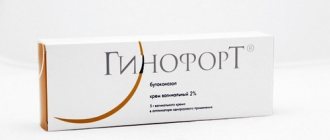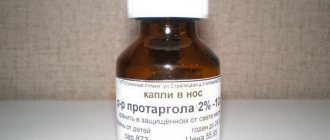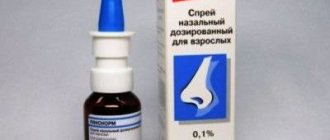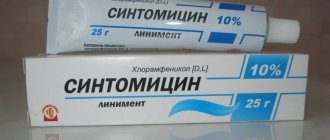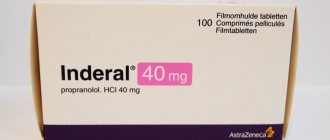| Clonidine | |
| Chemical compound | |
| IUPAC | N- (2,6-dichlorophenyl)-4,5-dihydro-1H - imidazol-2-amine |
| Gross formula | C9H9Cl2N3 |
| Molar mass | 230.093 g/mol |
| CAS | 4205-90-7 |
| PubChem | 2803 |
| DrugBank | APRD00174 |
| Classification | |
| ATX | C02AC01, N02CX02, S01EA04 |
| Pharmacokinetics | |
| Bioavailable | 75-95 % |
| Plasma protein binding | 20-40 % |
| Metabolism | Hepatic inactive metabolites |
| Half-life | 12-33 hours |
| Excretion | urine (40-50%) |
| Methods of administration | |
| oral, intramuscular | |
| Other names | |
| clonidine | |
| Media files on Wikimedia Commons | |
Clonidine
(trade names:
Clonidine
,
Catapresan
,
Gemiton
,
Chlofazolin
,
Atensina
,
Capressin
,
Clonilon
,
Hyposin
) is a drug, an antihypertensive drug of the group of imidazoline derivatives, a stimulator of α2-adrenergic receptors and central imidazoline receptors. Widely used in the treatment of arterial hypertension.
Story
The drug was synthesized in the 60s. At first it was planned as a remedy for the common cold due to its peripheral adrenergic stimulating effect and the ability to spasm the capillaries of the nasal mucosa. However, its hypotensive properties were immediately noted. Clonidine has been used as an antihypertensive drug for several decades in the USSR and abroad. The peak of its popularity was in the late 70s and early 80s. It was often combined with other drugs. Its largest producer in the USSR was the Organika plant.
Contraindications
The medicine has a number of contraindications:
- low blood pressure;
- atherosclerosis of cerebral vessels;
- condition after a heart attack;
- poor conduction of cardiac impulses;
- depression;
- pregnancy at any stage;
- lactation period;
- work that requires attention;
- consumption of drinks containing alcohol;
- simultaneous use of antidepressants in therapy or antipsychotics.
Pharmacodynamics
Clonidine is an antihypertensive agent whose action is associated with a characteristic effect on the neurogenic regulation of vascular tone.[1] Along with guanfacine, naphazoline and oxymetazoline, it is an α2-adrenergic agonist. Like naphazoline and oxymetazoline, clonidine stimulates peripheral α1-adrenergic receptors and has a short-term pressor effect. But, penetrating the blood-brain barrier, it stimulates α2-adrenergic receptors and I1-imadazoline receptors of the nucleus of the solitary tract (nucleus of the solitary tract), which excites inhibitory interneurons of the vasomotor centers located at the bottom of the rhomboid fossa of the fourth ventricle, and excites the posterior (dorsal) nucleus of the vagus nerve , which enhances the influence of the parasympathetic system on the heart. This reduces the efferent flow of sympathetic impulses from the central nervous system and reduces the release of norepinephrine from nerve endings, producing a sympatholytic effect. The same mechanism inhibits the secretion of adrenaline by chromaffin cells of the adrenal medulla.
Due to a decrease in the secretion of catecholamines, a hypotensive effect occurs. With rapid intravenous administration, the hypotensive effect may be preceded by a short-term (several minutes) increase in blood pressure due to stimulation of vascular α1-adrenergic receptors. In this regard, intravenous use of clonidine is limited. In elderly people, intravenous clonidine is not used due to the risk of stroke or myocardial infarction during the hypertensive phase. The hypotensive effect usually develops 1-2 hours after taking the drug orally and continues after a single dose for 6-8 hours.
The hypotensive effect of clonidine is accompanied by a decrease in cardiac output and a decrease in peripheral vascular resistance, including renal vessels. Clonidine also causes a decrease in intraocular pressure associated with a decrease in secretion and improved outflow of aqueous humor. Due to its effect on the central nervous system, the drug has an analgesic effect.
An important feature of clonidine is also its ability to reduce (and remove) the somatovegetative manifestations of opiate and alcohol withdrawal. The feeling of fear decreases, cardiovascular and other disorders gradually disappear. It is believed that these phenomena are largely due to a decrease in central adrenergic activity that occurs when clonidine excites α2-adrenergic receptors of inhibitory neurons. The depressant effect of clonidine on the central nervous system also results in sedative and hypnotic effects, as well as a decrease in body temperature.
Overdose of clonidine
Symptoms of clonidine overdose include:
- hypotension,
- bradycardia,
- drowsiness,
- irritability,
- weakness,
- miosis,
- vomiting
- respiratory depression,
- cardiac arrhythmia,
- to whom,
- shortness of breath,
- convulsions,
- short-term increase in blood pressure.
Clonidine poisoning can occur when:
- accidental ingestion by young children,
- admission for suicidal purposes,
- criminal reason.
Pharmacokinetics
The bioavailability of clonidine for conventional dosage forms is 75-85%, for extended-release preparations - 89%. The drug begins to act in less than an hour with a duration of action of 6-10 hours, the greatest hypotensive effect develops within 2-4 hours. Peak concentration in blood plasma is reached after 1-3 hours (for prolonged forms - 7-8 hours). The connection with blood plasma proteins is 20-40%. Volume of distribution - 2.9 l/kg. Metabolized in the liver, the half-life is 12-16 hours, 40-60% of the drug is excreted in the form of metabolites in the urine.[2]
Composition and release form
Pharmacology produces clonidine in the following forms:
- tablets containing 0.15 mg of active substance or 0.075;
- a solution containing 0.01 percent, 0.25 or 0.5% clonidine for intramuscular or intravenous use;
- ampoules with 1 mg of the substance (it is administered intravenously with saline);
- powder in large packs of 0.5-10 kg in each package;
- tubes with a solution of 0.125 mg, equipped with a dropper.
In addition to the main active ingredient, the tablets contain lactose monohydrate, as well as magnesium stearate with potato or corn starch. The tablets have a flat-cylindrical shape, white or slightly yellowish color.
The ampoules do not contain auxiliary components, while liquid solutions, in addition to clonidine, contain water for injection and hydrochloric acid.
Application
Clonidine is a centrally acting α2-adrenergic receptor agonist. The drug penetrates the blood-brain barrier and acts on receptors in the hypothalamus, causing a decrease in blood pressure.
Clonidine can also be used as an adjuvant drug during epidural anesthesia to relieve severe pain in cancer patients in cases where the pain is not well controlled by opiate analgesics alone.
In addition, clonidine is used for the differential diagnosis of pheochromocytoma in patients with arterial hypertension.
Other uses of clonidine: prevention of vascular migraine headaches, treatment of severe dysmenorrhea, relief of vasomotor symptoms associated with menopause, rapid detoxification in the treatment of opiate withdrawal syndrome, in combination with benzodiazepines - treatment of alcohol withdrawal, nicotine addiction. Local forms of the drug are used to reduce intraocular pressure in the treatment of open-angle glaucoma, secondary glaucoma and hemorrhagic glaucoma associated with hypertension. Clonidine can also be used as a therapy for attention deficit hyperactivity disorder (ADHD), including in combination with psychostimulants to reduce their side effects[3]. However, as monotherapy, clonidine is inferior to desipramine in the treatment of ADHD symptoms[3][4].
An overdose of clonidine, especially in combination with alcohol, leads to a rapid and prolonged decrease in heart rate with the simultaneous development of a hypnotic effect, accompanied by prolonged loss of consciousness (including death), and therefore “Clonidine” has become notorious as a means of committing serious crimes. crimes.
Use for criminal purposes
| The style of this section is non-encyclopedic or violates the norms of the Russian language. The following section follows the stylistic rules of Wikipedia. |
Clonidine has become notorious due to the fact that it is often used by criminals for their own purposes: when added to alcohol, it can quickly put the victim to sleep, and then search and steal money and valuables. This often ended in the death of the victim. There are many known cases of such use of clonidine by prostitutes in relation to their clients (the special term “clonidine specialists” arose), as well as, conversely, when it is used by clients of prostitutes in relation to the prostitutes themselves.
Clonidine is also used for criminal purposes by taxi drivers[5], who offer tipsy passengers to “catch up” (drink more), kidnappers and other criminals.
Causes of fatal poisoning
People take medications almost all the time. Often they do not think about the fact that a small dose of the drug or its interaction with other chemicals causes serious harm to health. Household poisoning with Clonidine (clonidine hydrochloride) is often classified as an accident. People with suicidal intentions take a lethal dose of a drug to kill themselves.
If the medicine is not stored correctly, a person may take Clonidine by mistake. Children, not realizing the consequences, consume large quantities of tablets, mistaking them for tasty candies in bright packaging. A fatal outcome occurs with an overdose of an antihypertensive drug if the patient self-medicates.
Low nutrient diet
Fasting, a diet low in nutrients, alcohol and drug use increases the threat of clonidine hydrochloride to human life and health.
Notes
- Clonidine (Clonidine, Gemiton, etc.)
- Clonidine (English). Medscape (WebMD LLC). Retrieved October 26, 2020.
- ↑ 1 2 Alan F. Schatzberg, Jonathan O. Cole, Charles DeBattista.
Manual of Clinical Psychopharmacology = Manual of Clinical Psychopharmacology. - M.: MEDpress-inform, 2014. - P. 495. - 608 p. — ISBN 978-5-00030-101-2. - Singer HS, Brown J., Quaskey S., Rosenberg LA, Mellits ED, Denckla MB
The treatment of attention-deficit hyperactivity disorder in Tourette's syndrome: a double-blind placebo-controlled study with clonidine and desipramine. (English) // Pediatrics (English) Russian. : journal. - American Academy of Pediatrics (English) Russian, 1995. - Vol. 95, no. 1. - P. 74-81. - PMID 7770313. - A taxi ride with a Caucasian driver cost a St. Petersburg resident 1.2 million // “Arguments and Facts”, 06/12/2016
Side effects
Clonidine can have the following side effects on the human body:
- Nervous system: asthenicity, lethargy, slowed reflexes, irritability, anxiety, depression, poor sleep, lightheadedness.
- Cardiovascular system: bradycardia, postural hypotension.
- Digestive system: attacks of nausea, vomiting, loss of appetite, diarrhea, constipation.
- Allergic manifestations: skin rashes, itching, difficulty breathing, sometimes swelling of the mucous membranes.
- Others: decreased libido, potency; deterioration of the urinary process, in rare cases - Raynaud's disease.
Interaction with other drugs
Clonidine, when used in combination with other medications, can either increase their effectiveness, inhibit their effect on the body, or have a side effect.
- People taking beta-blockers when discontinuing clonidine see sharp increases in blood pressure.
- The simultaneous use of Clonidine and hormonal contraceptives may increase the sedative effect of clonidine.
- Tricyclics: simultaneous use reduces the hypotensive effect of Clonidine.
- Clonidine: Concomitant use increases the duration of exposure to vecuronium.
- Verapamil: Concomitant use may cause heart block in people with hypertension.
- Prazosin: Concomitant use may alter the antihypertensive effect of Clonidine.
- Propranolol, Atenolol: parallel use may cause sedation and dry mouth.
- Cyclosporine: Concomitant use may increase the level of cyclosporine in the blood.
- Insulin: when used in parallel, may increase blood glucose levels.
Reviews
Victoria, 68 years old Clonidine has been saving me for 17 years; it lowers my blood pressure very well. True, constantly writing out a prescription for it is not very convenient and problematic.
Ekaterina, 47 years old In the evenings, my blood pressure rises to 180 to 110. I take Clonidine regularly, 1 tablet at night. A very effective remedy.
Igor, 56 years old This medicine is an ambulance. Quickly and efficiently. The main thing is to carefully read the instructions and contraindications so that there are no problems. The only drawback is that the pressure drops too sharply. But nothing could replace it.

